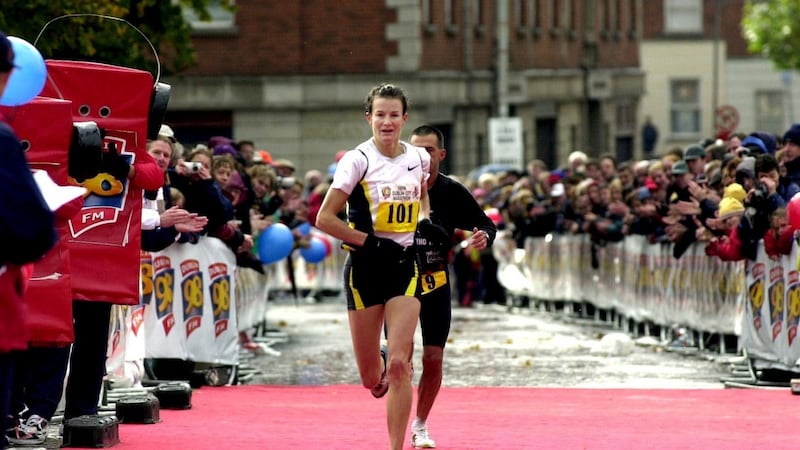There’s something about Dublin Marathon week. Runners from across the country, and from overseas, easing back on the miles and their training. All trying to find the perfect taper to deliver them as fresh as possible to the same start line.
All primed, they hope to be rewarded for the hours of training and sacrificed lifestyle over the past few months.
And all leading to Sunday, when the streets are closed down and the runners of all different abilities embrace the same marathon challenge. Running fast or slow, it’s such a uniquely shared experience. All in it together.
My first marathon was in Dublin, back in 2000, just over a month after returning home from the Sydney Olympics. It might easily have been a celebratory run around the capital, but it was all a bit of a secret. I just wanted a reason to get myself back running, to cast aside the endless celebrations on my return.
Why the record-breaking heights of Mondo Duplantis are truly out of this world
Sarah Healy produces lifetime best to take second in 1,500m at Diamond League in Paris
Father of double Olympic champion Jakob Ingebrigtsen found guilty of hitting daughter but avoids jail
Rhasidat Adeleke finishes sixth in 400m at Stockholm Diamond League meeting
And with that, to step back into my comfort zone of lacing up the shoes, preparing for some running with proper purpose and motivation.
I knew I would be in Dublin for the launch of my book, Running to Stand Still, the title just a little bit ironic as someone who doesn’t like to stand still for long. After getting a late, late entry, my plan really was just to finish. That didn’t quite work out, as I ended up winning the women’s race, running 2:35:42.

I ran on a whim. There will always be those who turn up every year, ever since the first Dublin Marathon in 1980. We’re down to 11 now, 10 men and one woman, who have completed them all.
Then there are the marathon virgins, all out to claim their very first finish, some crossing the line proclaiming never again, while others will be stepping into newfound territory where they cannot wait to come back and complete the feat all over again.
Like many things in life, the first time is always the one you remember most vividly. The reason you signed up, the training, the exhilaration on crossing the finish line and the lessons you learn along the way. These lessons are not just from the race itself, but the miles and hours of training put in just to get you to the start line.
This Sunday the Dublin Marathon will once again be at full capacity, with runners of all levels racing around the capital. I find it a little strange that most people who complete the race will probably not know or relate in any way to the elite athletes leading the way, chasing course records and prize money.
[ Dublin Marathon 2023 Q&A: Everything you need to know with a week to goOpens in new window ]
Because there is so much more to a big city marathon now than who can get to the finish first. Completing the marathon is the lowest common denominator among the thousands lined up that will have prepared for the big day. There is no shortage of online marathon programmes one can follow, local coaches and motivating training groups.
I have completed seven marathons, including Dublin, London, and New York, which in the big scheme of things is not that many. But each one was a different and fulfilling experience.
Running Dublin back in 2000 was definitely an eye-opener, certainly a shock to the system. I remember thinking it was just another long run at a decent pace. But it turned out to be a very different story, and my last memory is of the next day, when I experienced soreness like never before.
I had definitely gone somewhere beyond what I had ever done, and for that you get to payback with DOMS (Delayed Onset Muscle Soreness).
This was not anything I’d prepared for or experienced before, no matter how fast or hard I ran on the track. Maybe a little soreness after some time off and the restart to running, but this was on another level and there was no quick fix – just tolerate and ride out the waves of muscle soreness.

Looking back now, I’m sure the soreness was purely from running on the hard road surface in regular shoes. There was no carbon plates or super foam back then, and I probably saved myself even greater heartache by rolling around in regular training shoes.
I remember in that first marathon that when I got to 18 miles it was a case of breaking down the time and distance that was left. It presented a myriad of mathematical equations. Still, the only sure thing was every step forward was one step closer to the finish line.
Back then the finish line was in Smithfield. I don’t remember a whole lot about the route, but I remember it was cold and wet and there was nowhere near the crowds lining the streets that I experienced on my return to Dublin in 2015.
They say Dublin is the friendliest of all big city marathons, that it brings people out on the streets to support the runners and help them on their way, and I definitely felt that in 2015. I set out to run around three and a quarter hours, and found myself being carried along a close to three-hour marathon pace, loving every minute. Well, almost every minute.
I was always surrounded by runners going at a nice pace. That’s the thing, once you find your groove and people that you can run along in sync with, it can at times feel effortless.
It’s essential not to get carried away and to hold back, to always be in control of your effort, no matter what way you try to carve up – 26.2 miles, 42.2km is a long way, a lot of running to be done between start and finish.
Put aside any thought of the finish, just run the mile you are in. Embrace the energy from those around you both on the course and on the sidelines cheering. It will all be there on the streets of Dublin this Sunday, home-grown support to give that extra boost of adrenaline. It’s another of my lasting memories, the noise and the cheering from the sidelines, and that shared feeling of elation and waiting for every runner as they cross the finish line on Merrion Square.
All in it together.















